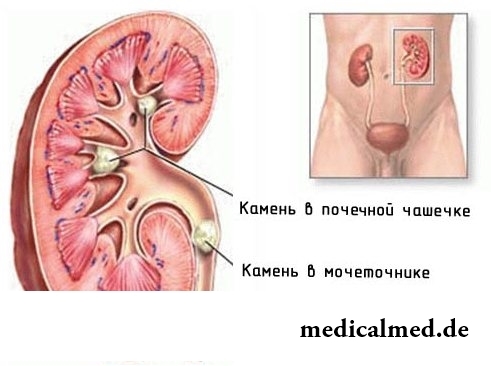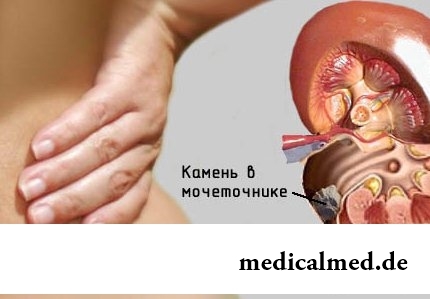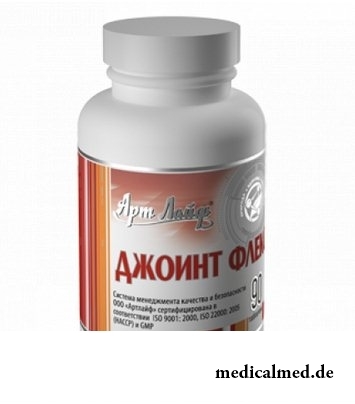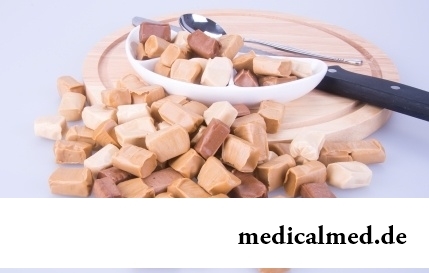





Urolithiasis

Urolithiasis (urolithiasis) – the disease resulting from disbolism at which in urine the insoluble deposit in the form of sand (to 1 mm in the diameter) or stones is formed (from 1 mm to 25 mm and more). Stones settle in urinary tract that breaks normal outflow of urine and serves as an origin of renal colic and inflammatory process.
According to medical statistics, the urolithiasis is on the second place on frequency among all urological diseases, and on the third place among the urological diseases leading to death. The urolithiasis strikes people of any age, including children, but the main age group - aged people from 25 to 45 years. The disease meets at men more often, than at women, however diagnose severe forms of a disease for women more often. It is also known that stones are more often formed in a right kidney, than in left, and approximately both kidneys are involved in 20% of cases in pathological process.
Urolithiasis reasons
In emergence of an urolithiasis the set of factors plays a role, at the same time up to the end the mechanism of formation of stones and its reason are not found out. It is known that the leading role is assigned to features of a structure of canalicular system of kidneys when the anatomical structure of a kidney promotes emergence of developments of stagnation. At the same time formation of stones requires also influence of external factors, mainly, of a diet, and also conditions of the drinking mode. Also in development of an urolithiasis diseases of urinogenital system, endocrine pathologies (especially the diseases of epithelial bodies directly influencing exchange processes with calcium participation), long reception of some medicinal substances play a role (streptocides, tetracyclines, glucocorticoids, aspirin, etc.).
Types of an urolithiasis
Various disturbances of exchange processes cause formation of the stones differing on the chemical composition. Chemical composition of concrements is important as medical tactics in treatment of an urolithiasis, and also correction of a diet for prevention of a recurrence depends on it.
In urinary tract the following concrements are formed:
- Stones on the basis of compounds of calcium (oxalates, phosphates, carbonates);
- Stones on the basis of salts of uric acid (urates);
- The stones formed by magnesium salts;
- Proteinaceous stones (tsistinovy, ksantinovy, cholesteric).

The main share is the share of compounds of calcium (about 2/3 all stones), proteinaceous stones meet most less often. Urates – the only group which gives in to dissolution. These stones come to light at elderly people more often. The stones consisting of magnesium salts most often are followed by an inflammation.
Stones at an urolithiasis can be formed in any department of urinary tract. Depending on where they are, distinguish the following forms of a disease:
- Nephrolithiasis – in kidneys;
- Ureterolithiasis – in ureters;
- Cystolithiasis – in a bladder.
Urolithiasis symptoms
The urolithiasis proceeds asymptomatically in the beginning. The first signs of an urolithiasis are found or is accidental, during inspection, or at suddenly come renal colic. Renal colic – the strong painful attack which is often the main symptom of an urolithiasis, and sometimes and the only thing, results from a spasm of an urinary channel, or its obstruction by a stone.
The attack sharply, begins with sharp pain which localization depends on localization of a stone. The megalgia, can give to a groin, a stomach bottom, a waist. The urination becomes painful and speeded up, in urine blood (hamaturia) is found. There is nausea, sometimes vomiting. The patient rushes about in search of situation which would give relief, but does not find such situation. The attack of renal colic can pass with a zatikhaniye and an exacerbation of pain and to end with either removal of a stone, or subsiding of colic, or the developed complication.
It is necessary to notice that expressiveness of signs of an urolithiasis is not always connected with the size of stones. Sometimes the concrements of the small sizes which are not exceeding 2 mm can cause the most severe colic whereas cases of severe damage of kidneys when the multiple stones which grew together in korallovidny educations do not lead to colic meet, and are found accidentally or when urolithiasis complications begin.
Diagnosis of an urolithiasis
Diagnosis of an urolithiasis happens on the basis of a characteristic clinical picture of renal colic and data of ultrasonography. Also computer tomography and magnetic and resonant urography are informative. Carry out the developed analysis of urine, using functional trials (across Zimnitsky, Nechiporenko, etc.). The bacteriological research of urine is obligatory. The X-ray analysis lost now the leading place in diagnosis of an urolithiasis, however is still used as an additional method.
Treatment of an urolithiasis

The attack of renal colic is removed by means of drugs of spasmolytic and analgeziruyushchy action. The main treatment of an urolithiasis is carried out to lack of acute manifestations.
The urolithiasis is considered a surgical disease, however the urolithiasis caused by formation of urates it is possible to treat medicamentally, accepting the drugs dissolving these stones. Other types of concrements demand mechanical removal.
Treatment of an urolithiasis is performed by means of two main methods: lithotripsies and surgical. A remote shock and wave lithotripsy - an effective method of treatment of an urolithiasis at which stones in urinary channels break by means of a shock wave and then are removed with urine. The method perfectly proved, thanks to it indications to an operative measure at treatment of an urolithiasis were considerably narrowed.
Operations by means of which treatment of an urolithiasis is performed share on open and endoscopic, and also on organ-preserving and radical. Radical operation is removal of a kidney if it lost the function. A preference method in the choice of surgical treatment of an urolithiasis are the endoscopic techniques allowing to carry out a removing calculus without making a section in an abdominal cavity.
Prevention of an urolithiasis
Prevention of an urolithiasis is a necessary condition of full treatment as without it a recurrence is inevitable. A basis of prevention of an urolithiasis is observance of the diet normalizing a metabolism and biochemical composition of urine, and also observance of the drinking mode. The diet at an urolithiasis is developed depending on chemical composition of stones. So, at oxalates exclude dairy products, chocolate from food, and at uratny stones limit consumption meat. Extremely important condition is reception of enough water – 1,5 – 2 l a day.
The most rare disease – a disease the Kura. Only representatives of the tribe Faure in New Guinea are ill it. The patient dies of laughter. It is considered that eating of a human brain is an origin of a disease.

The summer of this year in Russia was very ambiguous. Regions suffered from a merciless heat, from pouring rains, from times...
Section: Articles about health
The modern person not always manages to find housing in the environmentally friendly region and such work which would not do harm to health. With food stuffs at first sight the situation is much better: shops are overflowed with goods which are positioned пр...
Section: Articles about health
The advantage of swimming for the person is so high that this sport is not only the most popular, but also is widely applied in medicine and rehabilitation processes. If you look for for yourself the occupation allowing pleasantly and to spend time, then swimming with advantage – the fact that it is necessary for you. And give learns several facts about swimming....
Section: Slideshow
For many spouses the question of planning of a family is one of the main. The choice problem effect at the same time comes out on top...
Section: Articles about health
Several decades ago the basil (the district khan, реан, Reagan) was considered as a part of the Caucasian or east cuisine, but today it strongly took the place on tables of Russians. Greens of this plant possess a strong, pleasant smell and specific fresh taste, because of to...
Section: Articles about health
Within several decades of our compatriots convinced that the use of butter nasty affects a condition of coronary vessels. As a result the reputation of a product was impaired thoroughly a little, and many almost ceased to include it in the diet, having given preference "to safer" to vegetable fats. Meanwhile, the last researches showed that harm of butter for health is strongly exaggerated. But the product has a number of unique properties, to...
Section: Articles about health
Epilepsy is one of widespread neurologic diseases. To parents, whose children suffer from this illness, it is necessary...
Section: Articles about health
Any of us is not insured from a heavy illness of the loved one. Happens and so that someone from family members becomes the bed patient, and remains in such state for a long time. It extremely suppresses both the most injured, and all it to...
Section: Articles about health
Scientists have no unambiguous opinion on a proximate cause of emergence of a carcinoma cutaneum today. Only the factors promoting development of this illness are precisely established. Treat them: long impact on skin of ultraviolet rays, radiation exposure, thermal injuries, injuries of skin by aggressive chemicals (pitches, acids, alkalis, etc.), genetic predisposition (existence of malignant new growths of skin in the family anamnesis), at...
Section: Articles about health
Sugar - the digestible refined product which is not of special value for an organism of the modern person. Use...
Section: Articles about health
So, you resolved to lose weight. And now you try to understand what to begin with: from exercise stresses or a diet? And how to make that process of weight loss did not give you an inconvenience, and, on the contrary, brought joy?...
Section: Slideshow
Bulimia and anorexia, are heavy deviations of a feeding behavior, become a cause of death of patients much more often than all other nervous breakdowns combined. In 60% of cases two illnesses accompany each other: patients feel horror before danger of set of excess weight and try to refuse as often as possible food, but periodically suffer from attacks of sudden hunger and an uncontrollable overeating. Each patient with anorexia and bulimia needs the help qualified пс...
Section: Articles about health
Wood louse – the ordinary-looking unpretentious plant extended in all territory of our country. It quickly expands, and sometimes for...
Section: Articles about health
Small appetite at the child – the complaint which pediatricians should hear practically from each mother. Most often it is carried to the category of children's whims, however the refusal of food in certain cases can be to alarming symptoms therefore it cannot be ignored....
Section: Articles about health
Food with the increased content of sugar is attractive to most of people - it is scientifically confirmed fact. Business here not in intemperance or dissoluteness: the sweet food is associated since childhood with feeling of rest and safety which tests the kid when it absorbs maternal milk. Besides, getting into a human body, sugar strengthens production of "happiness hormones" which all of us so need. And still life of sweet teeth seldom happens cloudless: their too big loss...
Section: Articles about health
Scientists always aimed to offer fundamental explanations for medical problems. Their theories formed the basis of modern methods is treated...
Section: Articles about health
All of us, unfortunately, should face flu nearly an every year. It would seem, so frequent disease has to be studied already up and down, and each person, at least once by it had (and the number of such people in our country aims at 100%), a dolzha...
Section: Articles about health
The popular expression "run from a heart attack" became the motto of the people supporting active lifestyle. Moreover, run became a peculiar fashionable tendency: sales of racetracks and the accompanying goods for run are at permanently high level. Whether really it is possible for one and all people and it is necessary to run to receive the portion of health, a charge of cheerfulness and good mood?...
Section: Articles about health
During foot walks blood moves on vessels more actively and one and all bodies are supplied with a large amount of oxygen. N...
Section: Slideshow
Each failure in work of bodies and systems of a human body is, as a rule, shown by the whole complex of symptoms. In particular, malfunctions with health often cause emergence of cosmetic defects in the form of rashes on a face. Experienced doctors know that локализац...
Section: Articles about health
Life expectancy in various regions of Earth is not identical. Social stability, economic wellbeing, availability and level of medical care, household comfort, literacy of the population in the field of respect for sanitary and hygienic norms and many other factors exert impact on it. However one parameter remains to the general almost for all countries of the world: women on average live for 7-10 years longer, than men. Today we will talk about the reasons of this phenomenon....
Section: Articles about health
According to doctors, more than a half of men of 25-50 years suffer from frustration of the urinogenital sphere, but sees a doctor from them меньшинс...
Section: Articles about health
Neurosis is called pathology of a nervous system at which deviations in functioning of the highest nervous processes are observed. Most often - owing to yet not strengthened mentality - children are subject to neurosises. Premises to emergence of such disturbances can become нез...
Section: Articles about health
Season of activity of viral infections in the heat. Everyone can get sick, but probability of this unpleasant event it is possible and it is necessary to minimize. There is a number of rules, following to which will help or to avoid absolutely infection with flu or a SARS, or to have an illness benign and without essential complications. About ways of prevention of seasonal infections the speech in this article will also go....
Section: Articles about health
Condition of lips (their morbidity, outward) – one of indicators of health of the person. Peeling, dryness, pallor, and also трещ...
Section: Articles about health
Transfusion of donor blood has almost century history. In spite of the fact that this procedure is quite usual for many people, process of blood donation is still surrounded with numerous myths. Today we aimed to discredit the most widespread of them....
Section: Articles about health
Maternal milk is the best food for the newborn. It is the unique natural product containing an optimum set of nutrients, and which is best adapted in order that the baby normally developed and it was protected from harmful factors of external environment, unusual for it. Unfortunately, breastfeeding process not always does without complications. Sometimes, that the kid begins to bite a breast, giving to mother an essential inconvenience. Some women...
Section: Articles about health
